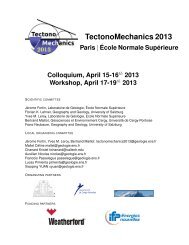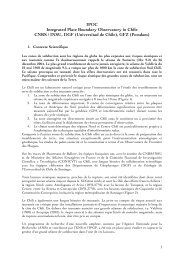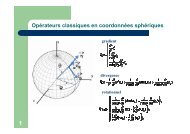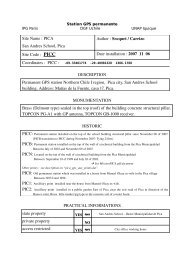PDF file - Laboratoire de Géologie de l'Ecole normale supérieure - Ens
PDF file - Laboratoire de Géologie de l'Ecole normale supérieure - Ens
PDF file - Laboratoire de Géologie de l'Ecole normale supérieure - Ens
You also want an ePaper? Increase the reach of your titles
YUMPU automatically turns print PDFs into web optimized ePapers that Google loves.
VIGNY ET AL.: GEODETIC MEASUREMENTS MONITOR ASAL RIFT DEFORMATION<br />
geo<strong>de</strong>tic studies show that the plate rates consistent<br />
with the GPS observations are about 30% slower than<br />
the NUVEL-1A estimates for Arabia-Eurasia<br />
[McClusky et al., 2000, 2003; Sella et al., 2002;<br />
Vernant et al., 2004; Vigny et al., 2006] and Arabia-<br />
Somalia [Fernan<strong>de</strong>s et al., 2003; Vigny et al., 2006] .<br />
These results suggest that spreading in the Red Sea<br />
and the Gulf of A<strong>de</strong>n, and thus the convergence rate<br />
between Arabia and Eurasia, have slowed during the<br />
last 3 Ma [Vigny et al., 2006].<br />
At the smaller, regional scale of the Afar<br />
Depression, the complexity of the active fault and rift<br />
systems leads to various interpretations. Tectonic<br />
observations and paleomagnetic <strong>de</strong>clinations suggest<br />
that the Danakil and Ali Sabieh blocks are both<br />
rotating [Sichler et al., 1980; Courtillot et al., 1980;<br />
Souriot and Brun, 1992; Manighetti et al., 1998]. The<br />
rotations can be un<strong>de</strong>rstood as a consequence of rift<br />
propagation, either as “oceanic micro-plates” [Acton<br />
and Stein, 1991] or “continental bookshelf faulting”<br />
[Tapponnier et al., 1990; Sigmundsson et al., 1992;<br />
Manighetti et al., 1998; 2001a and b]. Implicit in all<br />
these mo<strong>de</strong>ls is the i<strong>de</strong>a that the <strong>de</strong>formation transfers<br />
from one rift to another and therefore evolves in space<br />
and in time. This complication makes evaluating these<br />
mo<strong>de</strong>ls by comparing their predictions to quantitative<br />
geo<strong>de</strong>tic measurements quite challenging. Confronting<br />
long-term, plate-scale mo<strong>de</strong>ls with short-term regional<br />
geo<strong>de</strong>tic surveys, requires accounting for the<br />
dynamics of the un<strong>de</strong>rlying processes.<br />
In this paper, we focus on the boundary between<br />
the Arabia plate and the Somalia where Sheba Ridge<br />
enters into the Afar <strong>de</strong>pression. This narrow, WNW<br />
trending zone of active volcanism and tectonics<br />
inclu<strong>de</strong>s Maskali transform fault, the Tadjoura rift and<br />
the Asal-Ghoubbet rift. To the NW, it links to the<br />
Mak'arassou fault system and the Manda Inakir rift<br />
(figures 1 and 2). The Asal-Ghoubbet rift is special<br />
because we can observe it on dry land to better<br />
un<strong>de</strong>rstand slow-spreading ridges in oceanic<br />
lithosphere. Reconstructing the edifice of Fieale<br />
volcano indicates an average spreading rate of 17 to<br />
29 mm/yr over the last 87,000 to 150,000 years at an<br />
azimuth of N40°E ± 5 that is consistent with plate<br />
kinematic estimates [<strong>de</strong> Chabalier and Avouac, 1994].<br />
The spreading rate is not constant, however, as<br />
evi<strong>de</strong>nced by a rifting event in 1978. Then, a swarm of<br />
earthquakes (two events had magnitu<strong>de</strong>s near 5)<br />
reactivated several normal faults, producing a total of<br />
2 m of extension, during a week of volcanic activity at<br />
a new eruptive center (e.g., Abdallah et al. [1979]).<br />
The geo<strong>de</strong>tic measurements performed during the<br />
years following this sequence corroborate the very<br />
high strain rates localized in the Asal rift [Ruegg et al.,<br />
1979; Ruegg and Kasser, 1987]. All these<br />
observations indicate that the Asal-Ghoubbet rift<br />
accommodates most of the present-day motion<br />
between Arabia and Somalia. Outsi<strong>de</strong> the rift, no<br />
direct measurements have yet been published to<br />
2<br />
<strong>de</strong>termine which other structure might accommodate<br />
any remaining motion.<br />
In this paper we present 12 years of GPS campaign<br />
measurements in Djibouti, Yemen, and Ethiopia. At the<br />
regional scale, we discuss the strain concentrated in the<br />
active rifts spanned by the GPS network. At the local<br />
scale, we use over 25 years of geo<strong>de</strong>tic data to argue<br />
that transient rifting episo<strong>de</strong>s like the one in 1978 at<br />
Asal are the dominant process in accommodating the<br />
motion across this plate boundary. Finally, we<br />
corroborate this interpretation by consi<strong>de</strong>ring the<br />
vertical displacements measured by GPS and leveling.<br />
GPS data analysis<br />
In November 1991, the first GPS observations were<br />
performed in Djibouti and the neighboring parts of<br />
Yemen and Ethiopia [Ruegg et al., 1993]. A small<br />
subset of this network was surveyed again in 1993 (3<br />
times), 1995, and 1997. More complete surveys of the<br />
rift network were performed in 1999, 2001, and 2003<br />
(Auxiliary Table 1). The points in Yemen were<br />
measured for the second time in 2001, ten years after<br />
the first survey. All sites were measured using a mix of<br />
Ashtech and Trimble dual frequency receivers<br />
equipped with different kind of antennas (see Auxiliary<br />
table 1 for <strong>de</strong>tails) During all campaigns, three points<br />
(Arta in Djibouti, Sana’a in Yemen, and Addis Abbeba<br />
in Ethiopia) were measured continuously in 24-hour<br />
sessions. Other sites in Djibouti were measured for 6 to<br />
24 hours a day over 1 to 6 days (Auxiliary Table 1).<br />
We reduce these data in 24-hour sessions to daily<br />
estimates of station positions using the GAMIT<br />
software [King and Bock, 2000] choosing the<br />
ionosphere-free combination and fixing the ambiguities<br />
to integer values. We use precise orbits from the<br />
International GPS Service for Geodynamics (IGS)<br />
[Beutler et al., 1993]. We also use IGS tables to<br />
<strong>de</strong>scribe the phase centers of the antennae. We estimate<br />
one tropospheric <strong>de</strong>lay parameter per station every 3<br />
hours. The horizontal components of the calculated<br />
relative position vectors are precise to within a few<br />
millimeters for pairs of stations less than 150 km apart,<br />
as measured by the root mean square (RMS) scatter<br />
about the mean.<br />
In the second step, we combine the daily solutions<br />
using the GLOBK software [Herring et al., 1990] in a<br />
“regional stabilization” approach [McClusky et al.,<br />
2000]. To <strong>de</strong>fine a consistent reference frame for all<br />
epochs, we inclu<strong>de</strong> tracking data from the permanent<br />
IGS stations around our study area available at the time<br />
of our campaigns (4 stations in 1991, 42 in 2003)<br />
[Neilan, 1995]. These fiducial stations are also inclu<strong>de</strong>d<br />
in the daily global GAMIT solutions from the IGS data<br />
center at Scripps, including more than 200 stations<br />
spread all over the globe. We combine all these daily<br />
solutions using Helmert-like transformations to estimate<br />
translation, rotation, scale and Earth orientation<br />
parameters (polar motion and rotation). The<br />
“stabilization” procedure <strong>de</strong>fines a reference frame by






